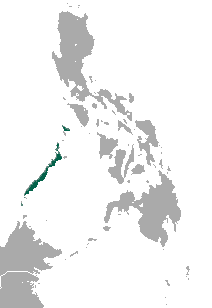Palawan fruit bat facts for kids
Quick facts for kids Palawan fruit bat |
|
|---|---|
| Conservation status | |
| Scientific classification | |
| Genus: |
Acerodon
|
| Species: |
leucotis
|
 |
|
| Where the Palawan fruit bat lives | |
The Palawan fruit bat, also known as the Palawan flying fox, is a type of very large bat. It lives in the forests of several islands in the Philippines. These islands include Palawan, Balabac, and Busuanga. This special bat is listed as vulnerable, which means its population is shrinking. The main reasons for this are hunting and the loss of its natural home.
What Does the Palawan Fruit Bat Look Like?
Palawan fruit bats are quite big bats. Their body, from head to tail, measures about 22 to 25 centimeters (around 9 to 10 inches). Their forearm, which is part of their wing, is about 13 to 16.5 centimeters long.
These bats do not have a tail. Their fur and wings are usually brown. Sometimes, their wings might have lighter brown spots.
How Palawan Fruit Bats Live
Like most large bats, the Palawan fruit bat is nocturnal. This means it is active at night. During the day, it rests and sleeps.
Unlike many other bats, this species does not gather in huge groups to sleep. They prefer to roost in places that are not easily seen. Scientists believe these bats mainly eat fruits, especially figs. A Palawan fruit bat can live for at least 5 years.
Why This Bat Needs Our Help
The Palawan fruit bat is considered a vulnerable animal. This means it faces a high risk of becoming extinct in the wild. Its numbers have gone down by more than 30% in the last 15 years.
There are two main dangers for these bats:
- Hunting: People sometimes hunt these bats.
- Habitat Loss: Their forest homes are disappearing. Many forests are being cut down to make room for farms or other developments.
Because these bats do not form large, easy-to-spot groups, it is hard for scientists to count them. This makes it difficult to know exactly how many are left. However, experts believe that more of their forest homes will be turned into plantations in the future. This makes protecting them even more important.


